Elizabeth Harrin's Blog, page 26
April 19, 2023
15 Easy Ways to Earn PDUs in 2023
Do you need to earn PDUs to maintain your PMI certification? You’re in the right place!
In this article, we’ll cover what you need to know about the different categories of PDUs and how many you need to get, plus some simple and free ways to earn PDUs in 2023.
There are also some further suggestions that take a bit more effort but are equally worthwhile in case you’ve got more time and energy to spare for your professional development.
Ready to get started? Let’s dive in!
What is a PDU?PDUs are professional development units. They are a measure of how much professional, continuous learning you have done.
PDUs are measured in hours. You can claim them in 15 minute chunks if you spend part of an hour on professional development.
How many PDUs do I need?If you hold a PMP®, PgMP®, PfMP® or PMI-PBA® certification, you need to earn 60 PDUs every three years.
That can be timed as 20 PDUs every year or 60 PDUs in the last 3 months of the three year cycle as you panic and try to get them all in before your certification expires.
If you hold a PMI-ACP®, PMI-RMP®, PMI-SP® certification, you need to earn 30 PDUs in a three-year cycle.
If you hold a CAPM® certificate, you need to earn 15 PDUs every three years.
The PDUs for every certification need to be made up of education undertaken in specific areas. More on that in a minute.
The tables below shows the different number of PDUs required for each certificate.
CertificationCertification CycleTotal PDUs RequiredEducation Minimum PDUsGiving Back Maximum PDUsPMP3 years603525PgMP3 years603525PfMP3 years603525PMI-PBA3 years603525PMI-ACP3 years301812PMI-RMP3 years301812PMI-SP3 years301812CAPM3 years1596These are detailed in the Continuing Certification Requirements (CCR) Handbook, so it’s worth getting a copy of that from the PMI website.
If you are close to your recertification deadline, read my guide on how to quickly earn PDUs for renewal.
PDU categoriesThere are two categories of PDU:
Education PDUsGiving Back PDUsEducation PDUsEducation PDUs are those earned from formal and informal learning across the three areas of the PMI Talent Triangle: Ways of Working, Power Skills, and Business Acumen.

Examples of ways to earn Education PDUs include:
Taking a course in-personAttending an online course, training session either live or as self-paced learningAttending a PMI Chapter meeting or PMI event where there is an educational sessionSelf-directed readingMentoring or other structured professional discussions with your colleagues and network e.g. lunch and learn meetings.CertificationTechnical PDUs RequiredLeadership PDUs RequiredStrategic PDUs RequiredRemaining PDUs from any Talent Triangle AreaPMP88811PgMP88811PfMP88811PMI-PBA88811PMI-ACP4446PMI-RMP4446PMI-SP4446CAPM2222Giving Back PDUsThe Giving Back category of PDUs are those earned from contributing to the profession and expanding your horizons through volunteering.
Examples of ways to earn Giving Back PDUs include:
Doing your day jobSharing your knowledge through publishing articles, podcasts, videos on your own website, your company website or a community platformGiving a presentation at an eventTeaching others.Maximum Requirements
CertificationWorking as a ProfessionalVolunteering & Creating KnowledgePMP817PgMP817PfMP817PMI-PBA817PMI-ACP48PMI-RMP48PMI-SP48CAPM24Download the CCR Handbook from the PMI website for a complete step-by-step breakdown of what you need for your particular circumstances.
How to maintain multiple PMI certificationsDid you realize that if you’ve got multiple certifications, your PDU activity can count for each one?
That’s a huge bonus! You don’t have to earn brand new PDUs for each certification. Simply do some professional development that earns you credit across your portfolio of certificates.
Make your PDUs do double duty supporting you for all your credentials!
Remember to report PDUs against all your relevant certificates in the CCR.
Power Skills and Business Acumen PDUs count for every certification you hold.Ways of Working PDUs can apply to more than one of your certifications as long as the subject is relevant. All Ways of Working PDUs count towards Project Management Professional (PMP)® maintenance, even if they are in a subject that feels more aligned to a different certificate, like the scheduling or risk credentials.
OK, now we’ve got that out of the way, let’s look at how you can boost your PDU count as quickly and easily as possible.
15 Easy ways to earn PDUsHere are some simple ways to earn PDUs for your PMI re-certification cycle. Many of these are free ways to get PDUs. Others are simple to do but come with a cost. There are loads of eligible activities to choose from, so let’s get started!
 1. Do your job
1. Do your jobDid you notice in the tables above that you can earn PDUs simply for doing your job? That’s got to be the easiest way to get started on your PDU total.
If you are working in any kind of project delivery role, PMO role, or similar in any industry, you can count some of your professional service working hours towards the maximum requirements for Giving Back.
You can use a copy of your job description as part of your evidence for this type of PDU claim.
You can’t claim a lot this way, so the best approach is to learn how to find time for continuous development as part of your regular schedule.
2. Claim for mentoringWhether you mentor others or are being mentored, you can claim that time as it is a structured professional discussion. You are working as a practitioner, so you’ve definitely got something to share with others.
Don’t have a mentor? I can help with that!
More formal coaching arrangements also work – record the hours you spend coaching others or receiving coaching. Talk to your manager to find out what options are available to you funded by your company.
3. Give a presentation at workIf you take a training course or attend a webinar, offer to give a 15-minute summary version to your team at the next team meeting. That’s 0.25 PDUs right there for knowledge sharing!
This is a simple way of earning PDUs for CAPM as it doesn’t require anything special to make happen.
4. Claim pre-course work and homeworkIf you are doing an online or in-person training course, you’ll probably be sent some pre-course work or assignments to do outside of class time.
You can claim the time you spend on reviewing the course material as self-directed learning. That’s on top of the hours you spend actually in the course itself – more on that later.
5. Listen to The PDU PodcastThis is honestly the easiest way to earn those PDUs. Sign up for The PDU Podcast. Get 60 relevant PDUs delivered to your device and watch them when you need them. Get your PDU certificate and enter the info into the CCR system.
It’s easy because then you’ve got all the PDUs you need for the whole renewal cycle at a low price per PDU, so you can rest easy. Also, you get a breakdown of exactly which webinars cover what Talent Triangle areas, so you don’t have to worry about working out what episode aligns to which Education section.
There are various different products depending on how many PDUs you need. I’ve used this product, listened to many of the podcast episodes and even been in some of the episodes! From my experience, this is a great, reliable way to earn PDUs backed up with excellent customer service.
Below you can see the options and choose the best product for your needs. Personally, I’m a fan of the Power Skills package because earning Power Skills PDUs is trickier than getting the Ways of Working PDUs.
PDUs with the Agile PrepCast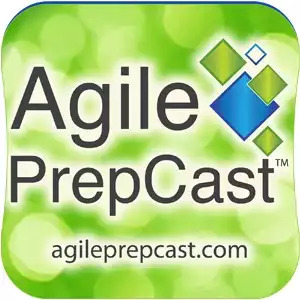 $129
$129 Earn 30.5 PDUs by listening to The Agile PrepCast and learning more about agile tools and methods.
Learn moreWe earn a commission if you click this link and make a purchase, at no additional cost to you #ad
PDU Podcast Power Skills Package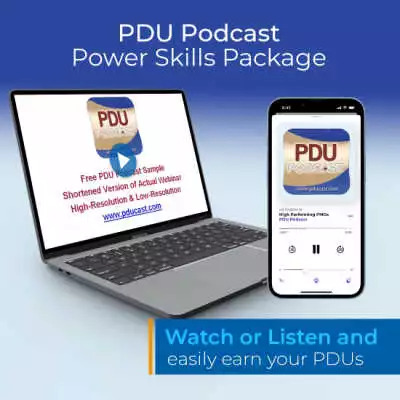 $49.00
$49.00 Get instant access to 10 high quality webinars on leadership and specialist topics to help you earn the difficult 'Power Skills' PDUs. The PDU Podcast Power Skills Package is perfectly aligned to the PMI Talent Triangle and gives you 15 PDUs.
Buy NowWe earn a commission if you click this link and make a purchase, at no additional cost to you #ad
CAPM PDU Package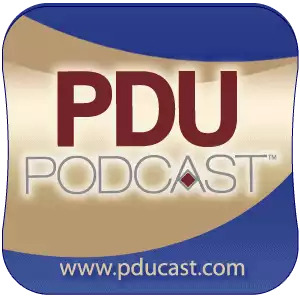 $49
$49 The PDU Podcast CAPM Package gives you fast, convenient access to the PDU learning materials you need. Simply add your subscription to your favorite free or premium podcast app, download the webinars and start earning your PDUs.
With The PDU Podcast CAPM Package you get instant access to 10 high-quality webinars on curated topics, perfectly aligned to the Talent Triangle®.
Buy NowWe earn a commission if you click this link and make a purchase, at no additional cost to you #ad
The PM PrepCast for PDUs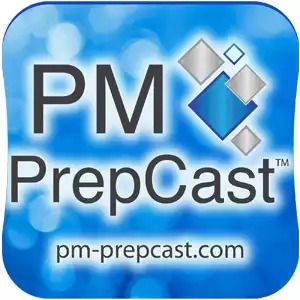 $199.00
$199.00 Earn all of the 60 PDUs you need to renew your PMP certification. It is aligned with the PMI Talent Triangle and includes a certificate of completion.
Buy NowWe earn a commission if you click this link and make a purchase, at no additional cost to you #ad
PDU Podcast $199.00
$199.00 Earn 60 PDUs by listening to these podcasts on your phone, mobile device, or computer. Learn from 25 project management experts when it is convenient to you, covering Ways of Working, Power Skills and Business Acumen.
Learn moreWe earn a commission if you click this link and make a purchase, at no additional cost to you #ad
6. Go to a meetingYou don’t have to be a PMI member to go to a Chapter meeting. And with more and more Chapters offering webinars online, you may find it easier than ever to get to an event.
Typically, PMI will only let you claim 1-2 PDUs for organization meetings per certification renewal cycle, so review the upcoming calendar for your local Chapter and see what events are coming up. Choose something that sounds interesting!
Do check first if there is a fee: some Chapters offer events free to members and charge non-members. You might decide it’s worth joining the Chapter if the events look good enough.
7. Take a courseThe easiest way to earn a lot of PDUs in one go is to take a class. This is a particularly good option if you hold more than one certification because you can break up the PDUs and use them to count towards the various re-certification requirements.
Online, self-paced video courses are good because you can fit them in around your work responsibilities, but any project management training will count.
I use the Coursera app on my iPad so I can study on the go and it lets you download video lessons so you can work even when you don’t have an internet connection. Check out my favorite project management courses on Coursera.
LinkedIn Learning is another option with loads of good courses.
I can also personally recommend the UVA Darden course if you want to improve your project planning, scheduling and tracking.
Do in a day Fundamentals of Project Planning and Management 5.0
Fundamentals of Project Planning and Management 5.0 A great short course from UVA Darden covering the basics at a good level. Best for project managers with some experience who want to improve their planning and project control.
See the course We earn a commission if you click this link and make a purchase, at no additional cost to you #adIf you prefer in-person learning, look into what your local community college is offering as evening classes or weekend study.
8. ReadingMembership of professional bodies normally comes with a journal or magazine. You can claim time for reading that, and heck, even this website!
Books also count, and there are some excellent project management books out there.
Just remember to write down what you learned and what you read, so you have an evidence log if you need to submit more information to PMI.
9. Watch a webinarGet started with the webinars here:
Tips for managing multiple projectsWhat it takes to be a successful project managerPractical strategies for managing your workThat’s at least a couple of free PDUs for you!
Online video is a simple way to learn new things, and it’s something you can fit into your lunch break at work. It’s also a good way to boost your leadership skills, as you’ll often find live and on-demand webinars covering leadership topics.
10. Contribute to a wikiIf you already have a Wikipedia login, you can start at the biggest wiki in the world and contribute your project management knowledge to that.
Or go small and contribute to the projectmanagement.com wiki, sharing what you know.
Perhaps you even have an in-house wiki for your team – that counts too.
11. Host a lunch and learn sessionOne of my favorite things to do at work was hosting the lunch and learn sessions. I curated a series of webinars over about a year. Project delivery professionals from all over the business joined the webinars (or watched the replays) over lunchtime.
It was surprisingly easy to organize in-house. You don’t need external speakers. Ask for volunteers to talk about what they learned on a project, or to do a deep-dive into something that went well (or not).
Or simply pull up an article on your favorite PM website, or a case study in a magazine and talk about what you would do in that situation.
I emailed the heads of departments about my lunchtime webinars and asked them to forward my message on. Then anyone who wanted to join the webinars could. I simply sent out a calendar invite to the people on the list.
You can claim PDUs for organizing the event and also speaking at it.
12. Spend time on ProjectManagement.comYou can earn PDUs for contributing to the community or watching videos. ProjectManagement.com is a website owned by PMI, and I think of it like the community wing. It’s packed with discussions, blogs, and other types of user-generated content, and it has a vast library of user-submitted templates.
There’s a huge selection of project management topics to browse.
Create content and join in! Write a blog post, contribute to a discussion, take a poll or a quiz, and start counting your hours.
13. VolunteerPersonally, I don’t think that’s an easy way to earn PDUs. It’s a lot of work and while it’s very rewarding, it’s not something to commit to without understanding what it involves.
Talk to your local organization first and see what volunteer opportunities there are. It’s free – and volunteer work will often get you into big events for free – but it’s not always ‘easy’.
However, if you have plenty of free time and live close to your local Chapter, then it might be an easier option for you. It’s also a great way to build a network of colleagues and make friends in the profession.
14. Take a PMI e-learning coursePMI have some video-on-demand learning courses, including some that are for free, like this introduction to Agile course.
PMI changes its offerings all the time (goodbye, PMI Edge) and right now there are 2 free courses on the PMI website that are going to give you PDUs: the PMI Kickoff badges.
Free training! Kickoff from PMIAn excellent free beginners project management course that comes in Agile and Predictive versions. Perfect for accidental project managers and people needing a structured approach to project work for the first time.
 Take the course We may earn a referral fee if you sign up #pmiaffiliate #ad
Take the course We may earn a referral fee if you sign up #pmiaffiliate #ad If you want a simple way to quickly earn PDUs, paying for them is definitely an easy route and there are plenty of paid training options like the Wicked Problem Solving course which is brilliant.
Opportunities that offer you badges, quiz results, certificates and so on are great because they give you evidence that you can easily refer to if your development record is ever audited.15. Study for your next certificateIf you are already going to study for something else, that study time counts. For example, if you study for the PMI-ACP using my recommended PMI-ACP prep course, you can record the time you spend on learning towards your PDUs for other certifications – as long as the content studied meets the requirements.
Extra ideas for earning PDUsFinally, here are a couple of extra ideas for earning PDUs. These ones don’t count in my book as ‘easy’ but they are certainly doable if you put the effort in.
You can create new content. That’s anything from an article in your company newsletter (as long as it is about something to do with project management) through to delivering a keynote speech or writing a book.
I don’t think that creating content for the project management community is particularly easy either, especially if you are new to putting yourself and your ideas out there. But if you want to improve your public speaking or corporate writing skills, then it’s definitely something you could do.
How to claim PDUsAll PDU claims are done via the CCRS system on the PMI website. Log on there and input your details. If you’ve undertaken some learning with a recognized PMI firm, they will give you a certificate or code to enter into the system.
Tip: I recommend you put a recurring calendar appointment in your diary to update the CCRS system every three months at least. Then you’ll be motivated to do it and have an up-to-date record of what professional development you’ve already done.PDU FAQHow long are PDUs valid?PDUs are valid for the re-certification cycle you earned them in (every 3 years). Once you have claimed the PDU for a re-certification cycle, you need to earn new ones to cover you for the next 3 years.
How many hours is a PDU?A PDU equals one hour of professional development time. It can be spend doing a variety of learning activities. You can also claim PDUs in 15 minute increments if your learning timeslot goes over one hour e.g. claim 1.75 PDUs for a webinar that was 1 hour 45 minutes long.
How can I get free PDUs?You can definitely get free PDUs for PMP renewal in 2023. Earn free PDUs from doing your job, listening to podcast episodes, volunteering, reading relevant materials and contributing to the profession, amongst other ways.
Next stepsReady to start collecting those PDUs to maintain your active status? Here are your next steps:
Download the CCR Handbook and familiarize yourself with the requirements.Sign up to The PDU PodcastRegister on ProjectManagement.com and put 30 minutes per month in your diary to contribute to the discussions, read the content etcStart collecting supporting documentation, PDU claim codes and evidence to back up your certification renewal.Pin for later reading

This article first appeared at Rebel's Guide to Project Management
How to Earn PDUs Fast in 2023
Is your re-certification cycle coming to an end for your PMI certificate? Do you need to quickly get your PDU total up to the minimum so you can stay certified?
You’re in the right place! Read on for tips on how to earn PDUs fast.
PDUs are the Professional Development Units you need to earn to show that you are invested in continuous improvement and ongoing learning.
The PMI Continuing Certification Requirements guidelines are laid out in the CCR Handbook, which you can download from the PMI website. That’s a good starting point to review what you actually need to earn. There are different requirements for each of the PMI certifications.
But time is ticking… let’s get on with the 7 ways to quickly earn PDUs.
 1. Review what you are eligible to claim
1. Review what you are eligible to claimHave you claimed everything you are already entitled to? Check your PDU totals on the PMI CCRS tool, as you might already have some logged.
Then review your calendar for the past 12 months (or go back further) and see if you have attended anything that you can claim for. Look for:
Training sessions or courses (internal or external)Organization meetings like attending PMI Chapter eventsSeminarsWebinarsConferences (virtual or in-person).Anything internal or external that covered project management topics could count, so make sure that’s on your record.
2. Claim for doing your day jobDid you know that you can claim up to 8 PDUs in the Giving Back category simply for working in a project-related role? Being a practitioner will earn you PDUs, and you’ll definitely want to include those!
Note that you can only claim 8 PDUs towards some PMI credentials like the Project Management Professional (PMP)®.
If you are earning PDUs for CAPM or other certifications, do check the handbook for the exact requirements. Some of the credentials won’t let you claim that many for doing your job.
3. Buy The PDU PodcastThe PDU Podcast is a video webinar-based learning tool that I love because it gives you 60 PDUs that you can either watch over the 3-year cycle or binge if necessary!
Of course, that means you then have to find 20 hours to watch a year’s worth of webinars, but if you can give up your evenings for a month, you’ll soon have a big batch of extra PDUs.
People sometimes struggle to earn the required Leadership PDUs, and The PDU Podcast can help with that too. There is a Leadership PDU package that just gives you the requirements for that part of the PMI Talent Triangle.
The other great thing about The PDU Podcast is that it is really easy to report the PDUs. There’s a handy spreadsheet that breaks down exactly which episode relates to which area of the Talent Triangle, so you’ll save even more time recording your efforts in the CCRS.
Here are some easy options for earning PDUs with the PDU Podcast, all of which I can recommend as I’ve listened to a ton of Cornelius Fichtner’s resources in the past (and I’m even in some of the podcasts!).
PDUs with the Agile PrepCast $129
$129 Earn 30.5 PDUs by listening to The Agile PrepCast and learning more about agile tools and methods.
Learn moreWe earn a commission if you click this link and make a purchase, at no additional cost to you #ad
PDU Podcast Power Skills Package $49.00
$49.00 Get instant access to 10 high quality webinars on leadership and specialist topics to help you earn the difficult 'Power Skills' PDUs. The PDU Podcast Power Skills Package is perfectly aligned to the PMI Talent Triangle and gives you 15 PDUs.
Buy NowWe earn a commission if you click this link and make a purchase, at no additional cost to you #ad
CAPM PDU Package $49
$49 The PDU Podcast CAPM Package gives you fast, convenient access to the PDU learning materials you need. Simply add your subscription to your favorite free or premium podcast app, download the webinars and start earning your PDUs.
With The PDU Podcast CAPM Package you get instant access to 10 high-quality webinars on curated topics, perfectly aligned to the Talent Triangle®.
Buy NowWe earn a commission if you click this link and make a purchase, at no additional cost to you #ad
The PM PrepCast for PDUs $199.00
$199.00 Earn all of the 60 PDUs you need to renew your PMP certification. It is aligned with the PMI Talent Triangle and includes a certificate of completion.
Buy NowWe earn a commission if you click this link and make a purchase, at no additional cost to you #ad
PDU Podcast $199.00
$199.00 Earn 60 PDUs by listening to these podcasts on your phone, mobile device, or computer. Learn from 25 project management experts when it is convenient to you, covering Ways of Working, Power Skills and Business Acumen.
Learn moreWe earn a commission if you click this link and make a purchase, at no additional cost to you #ad
4. Become a PMI MemberIt’s worth becoming a member and it only takes a moment (click here to join PMI).
Not only will you get cheaper certification renewal fees, but you’ll also get access to their own PMI PDU online learning resources – more on those in a minute.
5. Watch webinarsIf you are a PMI member, get yourself over to projectmanagement.com and start watching their free on-demand webinars. You could watch one every lunchtime for a month – that’s another 20 PDUs right there.
Each online video comes with a description that tells you exactly what you can claim in each of the different PDU categories.
You don’t even have to spend time updating the CCRS: anything you earn by watching PMI webinars is automatically credited to your PDU balance. You should get a confirmation email a couple of days later confirming that your PDUs have been added to your account.
If you aren’t a PMI member, you can still find PDU webinars online. Here are some of mine to get you started:
Tips for managing multiple projectsWhat it takes to be a successful project managerPractical strategies for managing your workOnline resources really are a fast way to earn free PDUs.
6. Use your commuting or gym timeLook for time in the day when you could (safely) multi-task on some professional development.
For example:
Commuting on the train: read a bookWorking out at the gym: listen to a podcastWaiting for the children to finish swimming lessons: read a professional journal, many of which are available online if you log in to the professional body’s websiteCooking dinner: play another podcastDriving to work: play another podcast.There are so many options to squeeze in a bit of learning. If you need some more inspiration, check out my 15 easy ways to earn PDUs.
Digital media gives us so many options! This might feel like informal learning, but it still counts. Remember, you can claim PDUs in increments of 15 minutes, so even if you spend a quarter of an hour reading a book, you can claim that time.
Tip: Use wifi headphones to play podcasts while you do other things. I have these wifi headphones in a headband. These aren’t the most pretty to wear during waking hours but they mean I can move around the house and still listen to podcasts playing on my iPad. I also wear them in bed and they are really comfy.You’ll maximize your time and earn PDUs quickly if you look for pockets of time where you can be learning and doing something else.
7. Take an online courseI get it, you don’t have time to study for a new certification right now. But what if you could find the time to do at least a few lessons on a self-study timetable? You don’t have to take an exam for the study time to count towards your renewals.
There are loads of courses available, through platforms like LinkedIn Learning and Coursera, as well as micro-credentials from PMI like the Citizen Developer course.
But how do you select something quickly without spending ages browsing through the huge selection online?
I’ve done the heavy lifting for you. Here are some places to get started:
10 Best Coursera courses for project managers (great if you already have a subscription to Coursera Plus or there is one available to you through work, but you can audit some of the courses for free and that would still count for PDUs).The best free online project management certificate courses (great for collecting evidence of your learning for your PDU records).Another option for PMP® certificate holders wanting to quickly earn more PDUs is The Agile PrepCast for PDUs. It’s different enough from ‘normal’ project management to be interesting, so you’ll learn something new. Plus, it’s delivered totally online, so you can watch and listen whenever it suits you. Binge as you please to fill up your PDU hours!
And if you want to go on and take the PMI-ACP® at any point, you now have the foundations down.
Earn PDUs PDUs with the Agile PrepCast $129Earn 30.5 PDUs by listening to The Agile PrepCast and learning more about agile tools and methods.
 Learn more We earn a commission if you click this link and make a purchase, at no additional cost to you #ad
Learn more We earn a commission if you click this link and make a purchase, at no additional cost to you #ad Check with your company: they may reimburse you for educational materials.
Tip: Check if your company offers study leave for professional development and formal training. The biggest challenge with finding time to earn PDUs is having to work as well. Use your allocated study leave time to catch up on your PDU balance.Create a planYou’re short of time, and the best way to get lots of things done in a short period of time is to have a plan.
Look at the suggestions above and choose how you are going to earn your PDUs the fastest way in the time you have available. Block out the time in your calendar to watch webinars and listen to podcasts.
Review what you need to get — specifically — because not all PDUs are created equal! For example, people often say that it’s hard to find ways to earn Power Skills PDUs. So if you need them, plan a way to get them.
Also, block out time to report PDUs.
Gather your evidenceIf you are earning PDUs fast, you’ll have a lot of similar dates in the CCRS. That’s not necessarily bad – let’s face it, many people leave their PDU recertification requirement to the last minute, so I’m sure PMI has seen it all before!
However, it might make you more susceptible to being audited. I have no evidence that this is the case, but if it was me sitting in PMI HQ reviewing your application for renewal, I’d want to make sure that you actually did do all the professional development in the few weeks when you said you did it.
That’s why it’s important to gather evidence to support your renewal. Prioritize learning providers who can give you a certificate or claim code for participating in their learning.
PMI-registered training providers are more likely to have a way of auto-certifying you for consuming their educational content, like those projectmanagement.com webinars.
Make sure your evidence is all there – you might need to earn them fast, but don’t scrimp on your PDU documentation because you’ll only be causing yourself a headache and a whole lot of extra work if you don’t have your records in order.
Change your approach going forward!The whole ‘cram as many PDUs as I can in the shortest possible time’ approach isn’t sustainable long term! It’s a lot of stress, and re-certification doesn’t have to be like that.
Think now about how you are going to pace yourself for the next cycle, for example, considering what Chapter events to attend next year. Make a plan to earn and report PDUs on a regular basis, so you avoid the last-minute rush.
Read next: How to make time for professional development.
Pin for later reading:

This article first appeared at Rebel's Guide to Project Management
Coursera Plus: Why It’s Worth It (in 2023)
As a project manager, we are always learning new things. If you hold a professional certification like the Project Management Professional, an APM qualification, or PRINCE2, you’ll also be expected to carry out some professional development each year as well.
And that all costs money – often money that our employers won’t pay for us. There is another way to build your skills and manage your budget: Coursera Plus.
What is Coursera Plus?Coursera Plus is Coursera’s subscription plan.
Coursera is a global online learning platform that has training material on a wide range of business-related topics. Think of it as an alternative to LinkedIn Learning, with content from world-class universities and tutors.
The Plus membership opens the doors to all of those online courses – there are thousands of courses.
There is a monthly or annual payment option. There is also a free trial, so you can check out what is included in the Plus program and make sure that you are comfortable committing to a subscription.
So what do you get for your money?
What’s included in Coursera PlusIt gives you access to 7,000+ courses and specializations (which are a collection of courses that lead to a certificate) with one monthly or annual subscription.
Over 90% of the courses on the platform are available with the Plus subscription.
You have unlimited access to the training from 170+ leading companies and universities. And you can earn certificates for all of them (there might be a few that don’t offer certificates – everything I looked at did, and Coursera advertises that you can earn unlimited certificates).
There are more than 15 Professional Certificate programs (including all the courses from Google) available too, but degrees and some other classes are excluded from the subscription plans.
How much is Coursera PlusThe cost of Coursera Plus in the UK is £49 per month or £331 per year ($59 USD per month or $399 USD per year), which represents a saving on the monthly version. The annual plan would be my recommendation if you know you want to commit to a year.
Alternatively, if you browse around and only want to buy one course, it might be cheaper to skip Coursera Plus and just go with paying for that course or specialization as a one-off. Courses range from £40-65 per month, with many programs being able to be completed in a month if you really go for it.
Check the pricing in your country, but it is going to be similar.
Benefits of Coursera PlusHere are 7 benefits of Coursera Plus, based on my experience using the platform for professional development.
1. Study anythingWant a course on work breakdown structures? Agile methods? How to give presentations? Coursera has all of those and much more.
Does Coursera Plus include all courses?
No, it does not. The subscription excludes online degree courses and training from some partners such as IBM and Stanford University. But with around 90% of the content available to Plus members, you will be sure to find a course to help you progress.
Use the search filters to find the right kind of courses for you.
2. Cost-effective learningCoursera has a free option, but the content is limited. For example, while you can audit the Google Project Management Certificate (auditing a course means you can see the materials), you can’t take the assessments or do the peer reviews without a subscription.
If you are planning on doing a few courses during a 12-month period then the Plus option gives you access to loads of quality learning materials without having to pay extra.
Recommended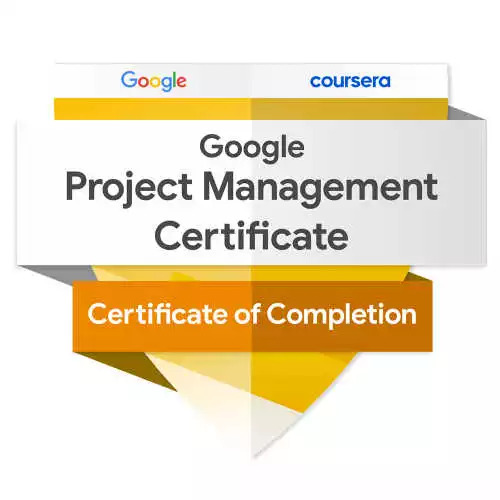 Google Project Management Certificate 5.0
Google Project Management Certificate 5.0 A solid, professional, well-recognized project management course from a great training provider. Perfect for beginners and people interested in learning more about project management as a career.
Learn more We earn a commission if you click this link and make a purchase, at no additional cost to you #ad 3. Fits with your scheduleHow many of us have the time to put aside a week for a classroom course? I can hardly believe that’s what I used to do. I can’t imagine it now: flexible learning is the way to go.
The good thing about online learning is that you can fit it around your day job.
For example, I listened to some Agile training while I was going about my other tasks. I downloaded the Coursera app and had that on my iPad, so I could watch the videos while I was cleaning my teeth and …er… doing other bathroom things, and I also had the videos on while cooking dinner.
I managed to get through a lot of the content without having to ‘sit and learn.’ Note: don’t do this if you feel like you learn best if you take a lot of notes. I would never have got the potatoes peeled if I had to stop and jot down notes all the time.
4. Earn certificatesThe main reason I signed up for Coursera is because I wanted certificates.
Does Coursera Plus include certificates?
Yes, it absolutely does!
Is it worth paying for Coursera certificates?
I think so, but you do have to acknowledge that they aren’t ‘worth’ as much as, say, a degree or a professional certification like the Project Management Professional (PMP)® that also recognizes your experience in the field and has certain eligibility criteria and a proctored exam.
I am a bit of a learning snob: I’m happy to learn stuff for the sake of it, but I am more motivated to learn when there is something at the end of it, like a Credly badge or a completion certificate that I can share on LinkedIn.
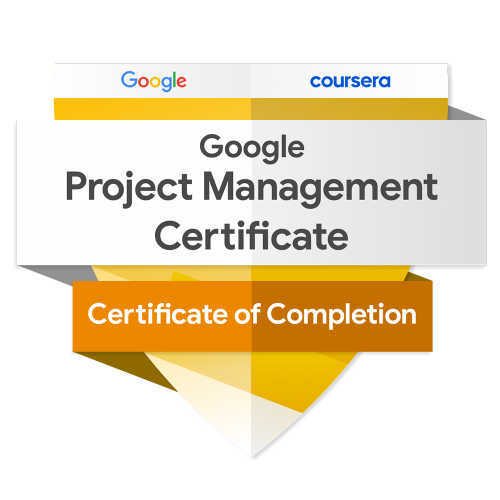 5. Respected by employers
5. Respected by employersCoursera is the platform that the training is hosted on. The training is delivered by world-class universities and training providers. For example, I did a course from IBM. I’ve also taken courses from Google.
Loads of universities have made their individual courses available on the platform, so if you are asking yourself if Coursera is respected by employers, I would say yes. You can probably find some courses on there from establishments that don’t carry the same kudos as a prestigious university, but employers will trust the development you’ve gained from leading educational establishments.
6. High quality contentThe quality of the video learning materials does depend on the provider, but the courses I have taken have been well-put together and taught by experts.
These are professionally-shot videos and professor-level instructors. It’s a high-quality learning experience, so you can guarantee that you are getting expert tuition.
7. Totally worth it!I can say that personally, I’ve gained confidence in Agile methods through the learning I have done on the platform. While I don’t work with a Scrum team on a daily basis, I do interact with Scrum Masters and Product Owners regularly, and it helps to know more about their world.
Is Coursera Plus worth it? 87% of learners on Coursera report career benefits, so yes, it is. As long as you use it.
Pros of Coursera PlusLovely user interface that keeps you motivated to complete the training. The design is good, it’s easy to use, and key dates are highlighted so you remember what you are supposed to be doing next. It steps you through the training, making it difficult to fail to complete the course.
Offline option. You can download the videos and transcripts to watch them when you are offline.
Easy to understand pricing. The pricing for Coursera in general is confusing. I couldn’t find out how much a course was until I’d enrolled in the free trial, and they do make it hard to know how much it will cost to take a whole certificate as the price is often based on monthly subscriptions (for professional certificates and Coursera specializations, for example). But the Plus pricing is easy to understand: it’s one price per month for everything.
14-day money back guarantee. If you pay for the premium subscription plan and get the annual option, you have 14 days to check it out. Do use this time, as if the subscription service isn’t for you, this is your moment to cancel it.
Forums. One thing I have enjoyed about the courses I’ve taken is the option to participate in forums. There are thousands of students online (and plenty of social proof about what it means for their careers), and the majority are willing to chat in the forum. That makes learning a social experience, even though you are at home.
Tip
Networking in the Coursera Forums can be very helpful to share experiences, networking, and get advice from other project managers.
Cons of Coursera PlusMany beginner courses. Most of the courses I looked at were aimed at beginners. You’ll have to dig to find content aimed at career professionals with more experience. There’s nothing wrong with going over the basics, but if you have been doing a job for a while, try to seek out the modules that will help you the most to save time.
Time commitment. You’ll get the most out of Coursera Plus if you do two courses in a year, or some learning every month. That is a commitment. Go for a monthly subscription if you aren’t sure you can keep that level of learning up for a whole year.
Might have additional costs. Check what Coursera courses are included in the Plus subscription before you sign up, as if the one you want to do is no, you might incur additional costs.
Other considerations before you sign upThere are a few other niggles I had with it. For example, they constantly talk about earning a ‘shareable certificate’. All that means is you can directly share the image of your certificate to LinkedIn, and it includes a link back to verify your achievement on their platform if an employer wanted to check out that you had actually earned it.
All certificates are ‘shareable’ – I could photocopy a certificate and send it to you. It feels a bit ‘social media’ but I get the sentiment, and these days when you could mock up something in Canva it is good to have the validation of a link back for evidence.
Know your goalsFinally, it’s really important to have some idea of your career goals before you sign up. Is it worth your time to learn about data analytics? Should you focus on Excel for Business? What about social sciences, leadership, financial accounting…?
You could go down the Coursera rabbit hole and end up studying a wide range of topics that will have no impact on your career prospects at all, so go in with a game plan!
My top 10 recommended courses on Coursera will give you a good starting point.
Are you ready to check it out yourself? Sign up for a free 7-day trial and have a look around. I’ll see you there!
Coursera PlusUnlimited access to 7,000+ world-class courses, hands-on projects, and job-ready certificate programs in a monthly subscription program.
 Learn More We earn a commission if you click this link and make a purchase, at no additional cost to you #ad
Learn More We earn a commission if you click this link and make a purchase, at no additional cost to you #ad This article first appeared at Rebel's Guide to Project Management
April 17, 2023
What to do when your project closes early: A guide
Closing down a project early is very different to carrying out a controlled close when a project has reached its natural conclusion and delivered everything that stakeholders were expecting.
It’s more emotional, for one thing. You’ve invested time in this work, and now it’s being moved to the scrap heap.
When a project is unexpectedly closed early, it can be difficult to know what steps to take next. Should we just give up on it? Move on and forget it ever happened?
That’s not the right way to handle terminating a project early. With the right approach and strategy, you can assess the situation, develop an action plan and implement it effectively so that your team learns from this experience for future projects.
Even if there was nothing you could have done differently.
So whether your project is on its last legs, or you’re just planning ahead for the future, in this article you’ll learn what to do when a project is closed early.
Why do projects close early?There are several reasons for early project termination:
The project is no longer required, perhaps because the organizational strategy has changedThe project can’t deliver what it set out to deliver for whatever reason, so the organization decides to cut its losses and stop the work.Actually, that’s about it. It’s humans that stop the work, so the decision is taken by a senior leader, often not the project sponsor.
Someone decides that the project shouldn’t carry on. Sometimes that’s to do with internal politics; sometimes there’s a very good reason that is clear to everyone.
Other times, a project can be stopped because other work takes priority, but it’s not fully closed – just put on ice until there are resources and time available to pick it up again.
But let’s say you have been told your project will be shut down before its scheduled completion date, and not because you’ve completed all the work early. Here’s what to do.
Identify the cause of closureAnalyze the impact on project goalsDevelop a closeout planImplement the closeout planEvaluate what you didThank the team (a lot, as long as it’s deserved!)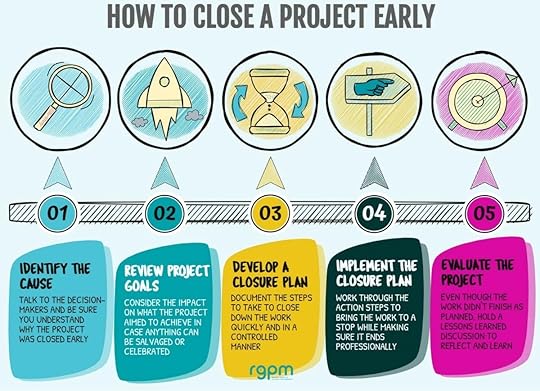 1. Identify the cause of closure
1. Identify the cause of closureWhen a project is closed before the scheduled end, it is important to assess the situation in order to make sure everyone understands the cause of closure. Analyze the impact on project goals.
You might think this is obvious: the CEO has told you to stop work. But it is really important to be crystal clear about why work has stopped.
At the very least, you have to explain it to the project team, and probably to the users who were expecting whatever it was you were delivering.
Everyone needs to have the same message and hear the same story.
Was there an external factor that was out of your control? Did something go wrong with the execution or planning process? Were there any unforeseen circumstances that impacted progress?
It’s important to get as much information as possible so you can understand why the project had to be shut down early, and share that on with people who need to know.
2. Analyze the impact on project goalsNext, consider the project’s goals and what the impact of the stoppage will be on those. You might think: “Well, we can’t achieve them at all,” but it’s likely you’ve already completed something of value.
What can be tidied up quickly and delivered? What can be mothballed for a future project? What did you manage to complete already – perhaps you already hit a couple of the project’s goals?
These are the little successes you can walk away with, and celebrate with your team. Of course, there might not be any at all… but if there are pieces of the project that can be used, implemented, taught, shared and celebrated, then do it.
Tip
Find the little successes and celebrate those with your team.
3. Develop a closeout planAs the project manager of a stopped project, you still have to bring the work (and the project team) to a controlled close. Your project lifecycle has come to an abrupt end, but fortunately you’ve probably already got an idea of what you would have done once the project reaches the end.
If you have a linear, predictive plan, or you have a PMO with a closure document template, then you can use that as the basis for your early close plan.
Work out your closeout plan: what you need to do to finish the job, albeit it was before you were all expecting to have to do so.
The activities you have to do are very similar to a planned project close:
Write a closure document that explains why the project was closed, including formal sign off and approval for the closure (because you don’t want anyone asking you why the work was stopped in a couple of months)Archive and file any project documentationCreate a financial report summarizing the state of play with the project budgetSchedule a lessons learned meeting or retrospectiveRelease the team back to the resource pool or their day jobsClose out any contracts – there might be penalties for not completing the work, so talk that through with the Legal team.In addition, you’ll want to package up any deliverables that can be used, or would be useful for other projects, and hand those over as well.
Document the tasks you have to do and make sure the team stays around long enough to help you do them.
4. Implement the closeout planUnsurprisingly, next you have to follow through on that plan.
Hopefully, your action steps can be completed in a matter of weeks, if not days. When a project gets stopped, it’s usually for reasons like running out of money or a change of strategy or executive leader, and no one wants a project hanging around after the decision has been made to terminate it.
Work quickly through your action plan, highlighting any potential risks that might arise as a result of this closing phase, and hand them over to the managers who can deal with them.
 5. Evaluate what you did manage to do and learn from the experience
5. Evaluate what you did manage to do and learn from the experiencePut that lessons learned meeting in the diary for as soon as possible, but not so soon that everyone will use the time to gripe.
I would organize two sessions – an informal one where everyone can express their shock, share their disappointment (or joy, I suppose it depends on what the project was), and whinge about the internal politics.
Then, when everyone has destressed from the experience, hold a more formal lessons learned. When everyone has a bit of distance from the shock, they’ll be able to share their feedback more constructively.
Ask questions such as “What do you think went wrong here?” and “How could we have prevented this outcome?” Listening carefully and taking notes during these conversations will help inform your next projects.
Let’s face it, if the project was cancelled by someone very senior, nothing you did or could have done would have made any difference to the outcome. But there might be some lessons in there that are still useful for future projects.
Assessing the situation is essential to understand why the project closed early and to determine how it affected stakeholders. This allows for reflection on what went well and what could have been improved upon, as well as identifying opportunities for growth and development.
Some of your project was completed, and it’s worth reflecting on and learning the lessons of that experience, even if you didn’t make it to the end.
Finally, it is important to share the lessons learned with team members who were involved in the project and stakeholders who may have had an interest in its outcome. This will help ensure everyone understands why certain decisions were made and provide an opportunity for collaboration moving forward so similar mistakes are not repeated.
Thank the teamYou’ve wrapped up the project, held the lessons learned meeting and all the info is archived away.
Don’t forget to thank everyone involved in the project for their hard work and dedication. Doing so will help create an atmosphere of appreciation and respect which can be beneficial for future projects. Especially as they’re probably all feeling rather fragile about what a failed project is going to look like on their project management resume.
Common questionsHere are some more queries I often get asked when I’m mentoring project managers about closing down a project prematurely.
What project management team role can trigger a premature close?
The project director or project sponsor can trigger a premature close by instructing the team to wrap up the work. But the suggestion that the work is closed down can come from anyone. As a responsible project manager or project team member, you can recommend that a project is shut down if that is the best course of action for the business.
Before you goHopefully, the experience of closing a project prematurely is something that won’t happen to you very often.
It’s more likely that your projects will follow through to their natural conclusion, however hard that might be.
In that case, you need to read my next guide: how to close a project effectively. That’s all about how to carry out the project closure phase in a low-stress way, so go and read that one next!
This article first appeared at Rebel's Guide to Project Management
April 13, 2023
The Best Free Online Project Management Certificate Courses (2023)
Project management is a great career. But how do you know it’s for you? And how do you show prospective employers that you are keen to commit to the job and you know enough about the role of a project manager for them to take a chance on you?
A certificate course helps you stand out from the crowd. I’ve taken plenty of project management certificates over the years – but mostly, they cost money.
However, there are some (good) free online project management courses with certificates out there.
If you are looking for training that will let you put your toes in the water of project management and give you something to show employers, then I have you covered. Below, I discuss the best options available for free online project management training that come with certificates so you can make the best decision for you situation.
I’ve focused on courses that are aimed at beginners because if you have some experience leading projects, you are probably beyond what most of the free courses can teach you (and hopefully you can have a chat to your manager about funding professional training for PMP, PRINCE2 or another qualification.
The list below contains affiliate links, but these courses are free or can be completed with a free trial subscription. I chose the courses based on quality, and ability to earn a certificate for free, as well as wanting to be able to personally vouch for the content.
Product Name / Product Image Rating Learn More Best place to start Kickoff from PMI 5.0 Take the course Recommended Google Project Management Certificate
5.0 Take the course Recommended Google Project Management Certificate  5.0 Learn more Comprehensive overview Project Management Foundations
5.0 Learn more Comprehensive overview Project Management Foundations 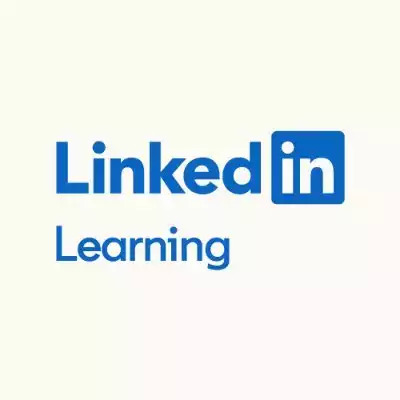 4.5 See the course Hands-on training Create a Project Tracker with Microsoft Excel
4.5 See the course Hands-on training Create a Project Tracker with Microsoft Excel  4.0 See the course Self-guided project Create a Project Charter With Google Docs
4.0 See the course Self-guided project Create a Project Charter With Google Docs  4.0 See the course Best place to start Kickoff from PMI
4.0 See the course Best place to start Kickoff from PMI  5.0 Take the course Recommended Google Project Management Certificate
5.0 Take the course Recommended Google Project Management Certificate  5.0 Learn more Comprehensive overview Project Management Foundations
5.0 Learn more Comprehensive overview Project Management Foundations  4.5 See the course Hands-on training Create a Project Tracker with Microsoft Excel
4.5 See the course Hands-on training Create a Project Tracker with Microsoft Excel  4.0 See the course Self-guided project Create a Project Charter With Google Docs
4.0 See the course Self-guided project Create a Project Charter With Google Docs  4.0 See the course 1. PMI Kickoff Waterfall
4.0 See the course 1. PMI Kickoff WaterfallPMI, the Project Management Institute, is one of the premium project management professional bodies in the world. It has a short course in predictive/waterfall project management tools and techniques called PMI Kickoff.
The best part is that you end up with a Credly badge (they used to be known as Acclaim badges) so employers can verify your achievement and you can share something worthwhile on your LinkedIn profile or resumé.
When I did this course I was pleased with how user-friendly the interface was, how interesting the content was and how smooth it was to work through the materials. It also comes with templates that you can download to help you manage your own projects.
I am not sure what I was expecting, but it was better than my expectations. A good, solid, free course with a quality badge at the end of it.
Time to complete: A couple of hours
Best for: Complete beginners who want to learn the basics of project management, people responsible for managing small projects at work but who have never had any formal training.
Certification received: Credly badge issued by PMI
2. PMI Kickoff AgilePMI has two flavors of the Kickoff badge: one is waterfall, and the other provides an introduction to project management from an Agile perspective. Why not do them both?
The same points stand as for the predictive/waterfall course: there is a badge available at the end of it, the user interface and student experience is good and it won’t overwhelm you as it’s very short but structured enough for you to come away with some helpful skills and templates.
Time to complete: A couple of hours
Best for: Complete beginners, people who work with agile teams but are not responsible for managing the overall team, people who want to learn more about agile.
Certification received: Credly badge issued by PMI
3. Create a Project Charter with Google DocsThe Create a Project Charter with Google Docs course from Coursera Projects Network is a hands-on project-based training. There are a few Coursera hands-on project courses that provide project management skills, and this was where I started.
I thought the training was well put-together and it’s very short, so it is perfect for when you are given a task and need somewhere to start.
Time to complete: 1.5 hours
Best for: People who have been asked to create a project charter for the first time and want support to feel confident they are including the right information in a professional format.
Certification received: Coursera certificate
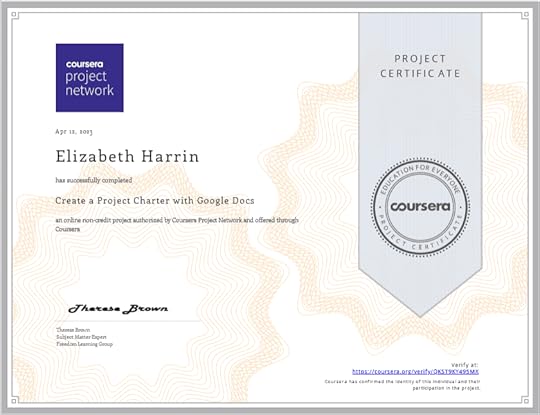 4. Create a Project Management Tracker using Microsoft Excel
4. Create a Project Management Tracker using Microsoft ExcelAnother free Coursera Project Network certificate, this one on creating a project management tracker spreadsheet will help you structure your work with dropdown lists and conditional formatting. You’ll make a spreadsheet to keep track of your project that you can share with the rest of the team.
My verdict on this online course was that it’s great to get you up to speed quickly with some simple Excel formatting like color-coding cells based on data validation that make your documents look much more professional.
Time to complete: 2 hours
Best for: New project managers who want a simple way to track their work (and they don’t have access to an enterprise project management tool so they are stuck with spreadsheets).
Certification received: Coursera certificate
 5. Project Management Fundamentals
5. Project Management FundamentalsThe Project Management Fundamentals course is taught by Bonnie Biafore – she’s pretty well-known in the project management community and is the author of many useful books, so she is definitely a trainer worth studying with!
The course covers the fundamentals of project management (ahem – clue is in the title) and a wide variety of topics from stakeholder analysis, requirements, creating a project budget, resource management, scheduling and monitoring and control. It is aimed at beginners.
Note that this one is only free if you complete it in your first free month of LinkedIn Learning membership. As it will take you a morning to complete, you can easily join LinkedIn Learning, claim your free month, do the course, get the certificate and then cancel.
Time to complete: 3.5 hours
Best for: New project managers who want a quick boost to develop formal skills.
Certification received: LinkedIn Learning certificate
6. Google Project Management CertificateThe Google Project Management Certificate is the most comprehensive and ‘best’ course on this list, but it is also the most challenging to get for free. It is one of the best online project management courses I’ve ever done.
The certificate is made up of 6 courses. The Fundamentals course is relatively straightforward with no peer-reviewed assignments, and you could definitely complete that within your free trial to claim the Coursera certificate for free.
But whether you could do the whole certificate… I found the agile project management course the most challenging personally, and if you have zero prior experience, the whole thing could be a challenge. Read my experience of taking the Google Project Management Certificate in a week and see if it is something you feel you could commit to.
I don’t know if you would be up for it or not, so I wanted to include it so you could make the choice yourself. It is the most respected course (in my opinion) on this list, and will be worth the most to a future employer because it is GOOD.
Time to complete: It is 6 months worth of content, paced at a topic per week. If you have the time, you can complete at least a couple of the courses and get the certificates within your free 7-day trial. Note that you will have to go some to get the whole certificate (6 courses) earned in a week.
If you are completely new to project management, think about spending 5-10 hours per week on this project management certification.
Best for: New project managers, people who want to become project managers.
Certification received: Coursera certificates per course, Credly badge for completion of 6 courses
Recommended Google Project Management Certificate 5.0
Google Project Management Certificate 5.0 A solid, professional, well-recognized project management course from a great training provider. Perfect for beginners and people interested in learning more about project management as a career.
Learn more Read my experience taking the course in a week We earn a commission if you click this link and make a purchase, at no additional cost to you #ad Are free certificates worth it?A free project management certificate is not worth as much to an employer as a paid one. I am saying that as someone who used to recruit project managers, and someone who now mentors project professionals and supports them with their job search.
When you pay for a course, you are paying for access to specialist training, exam prep materials, and the cost to the professional body for putting on the exam and maintaining their credential to a very high level.
I would not personally rate a free online project management training course as highly as one that you paid for.
Watch out!
If someone is telling you they can get you the Project Management Professional (PMP)® certification or exam for free, or PRINCE2 for free, I would be highly skeptical. These are certifications managed by professional groups and they do not give away their materials for free. Don’t fall for scams!
Non-certificate courses with audit modeIf you are open to taking courses in project management that don’t end up with a certificate, there are a lot more choices. EdX, LinkedIn Learning and Coursera all have plenty of training options that will help you understand project management principles. Sign up to take the class in audit mode.
Auditing a course means that you have access to most of the content but no access to graded assignments, exams, tests, timed quizzes or any other formal assessment. Typically, you need to complete the formal assessment to earn the certificate – and that’s the paid part.
If you are interested in learning for learning’s sake, or want to know how to manage successful projects but don’t need a piece of paper to prove it, then I would personally opt for either auditing the Google Project Management course (if you are a beginner) or a more advanced class taught by a university (if you have prior experience of project management in the workplace).
Take a class, if you love it and think it is worth it, pay for the upgrade to do the assessment and get the certificate.
Benefits of free project management certificatesHaving said what I said above, there are some reasons why you might want to spend time working towards a free certificate:
They will show you what is involved in the work to manage a project, so you can double check that it is the career for you.They show employers you have at least done some training, which is better than having no courses on your CV or resume at all if you want a career in project management.They help you understand the tools, techniques, jargon and skills involved in managing projects, so you can work effectively with a project team even in your first job.They are often quick to earn, as you can see from the course durations and descriptions above.You just need an overview of project management and don’t need in-depth project management courses to do your job.So I wouldn’t write them off completely. If you can’t afford paid training or don’t meet the eligibility criteria for some of the more advanced/popular courses, then free certificates might be your only choice.
Free courses for earning Professional Development UnitsProfessional Development Units (PDUs) are PMI’s continuous professional development scheme. Lots of professional bodies have requirements for their members to do training each year to keep their skills up, so you might be part of an association that calls continuous learning credit something different.
Another benefit of taking a free certification program is that you can improve your skills while also earning education hours that count towards renewing your membership.
However, I would argue that you don’t need the certificate or an exam to meet the requirements of your development scheme. Many courses will give you a transcript or certificate of completion, or you can take a screenshot of the amount of hours you have spent on the learning material from the software itself.
Personally, I wouldn’t limit myself to only courses that offered formal certification because you can meet and evidence your requirements for ongoing learning in other ways. Still, if it’s free and you get a shareable certificate at the end of it, that’s also good!
When you’re ready to upgrade to paidFree courses will only get you so far, so when you are ready to upgrade to paid classes, here are some I recommend:
Browse the project management training available with a Coursera Plus subscription.Check out my favorite PMP exam prep class when you are eligible for that.See if your company will let you expense a subscription to LinkedIn Learning and make the most of that.Happy studying!
This article first appeared at Rebel's Guide to Project Management
April 12, 2023
7 Hidden dangers of project management (Or why even well-planned projects sometimes fail)
Despite your efforts to clearly define the scope, time and resources necessary to successfully complete the projects, things simply don’t always go according to plan.
 Maja Mrsic
Maja MrsicHere are 3 examples of projects that didn’t go to plan.
During a company integration program, customer service levels dropped by 25-50% because the team management focused their efforts on reorganizing and changing employees’ roles and responsibilities, all with “the best of intentions”.
A bank’s inability to control several billion dollars of trust accounts because of hardware problems made all the depositors withdraw their trust money.
After $170m spent on a project to upgrade its computer system, the FBI project crumbled because the requirements were ill-defined from the beginning and the software didn’t function the way the agency had hoped.
These are just a few examples of projects that failed while wasting a tremendous amount of money and time.
The Standish Group’s CHAOS Report and other surveys report that project failure is more common than we would like. The more complex the project gets the more difficult it is to predict and control all the hurdles that may come up on the road to success.
Even if the team executes their tasks flawlessly and all the activities are carried out properly, we can never be sure that the project won’t flop.
So why do some projects crash to their doom? Here are 7 reasons for project failure so that you can avoid these on your projects.
1. Scope creepIt’s imperative to clearly define:
What the project will deliverWhen it will be completeHow much it will costWho will do the workHow the project will be done.However, as much as we would like to keep everything on the same page, changes happen. Whether it’s the client who decided to change the scope of the work or the team faced some unforeseen difficulties, changes can kill a project.
For example, in June 2010 Chrysler merged with Fiat. The merger was not a successful one. Merging required some major organizational changes such as introducing new technology, creating a new management team and alternation in business processes and policies.
Consequently, the difference in corporate culture led to numerous issues causing anxiety among team members. They were unable to adapt to upgraded technology and modern methods which, eventually caused the company to throw in the towel.
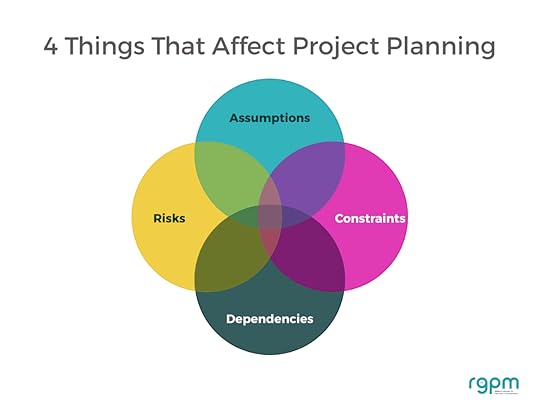 2. Miscommunication
2. MiscommunicationBig projects usually include multiple parties who all want to be an integral part of the project and who want to participate in decision-making process. While it’s to everybody’s benefit to produce the best possible results, people may have different goals and ambitions.
This is where the problems begin. Misunderstandings and conflicts arise, and the project starts to crumble.
Tip
Set meaningful and workable goals and put one person in charge of making final decisions.
Pixar, the computer animation film studio, established a group of people called “brain trust” who meet regularly to give some feedback on different stages of project development. While they are encouraged to talk about both positive and negative sides of the projects, the advice they give doesn’t have to affect the final outcome.
Whether some changes will be made or not depends solely on the film director’s point of view.
One thing that can bring the communication between all the parties to a whole new level is a project management tool. Active Collab helps your team stay organized, improves your project workflow and keeps everyone, from employees to clients, in the loop.
3. Working with the wrong peoplePMI’s Pulse of the Profession report shows that for every $1 billion invested in the United States, $122 million was wasted due to poor project performance.
No matter how much time you allocate to carefully plan all the steps of the project, your project will struggle if you don’t establish a well-trained team of talented and skilled people. Organizational changes may require talented employees to accept new challenges, take new responsibilities and live up to expectations.
However, when existing staff don’t have the right knowledge and skills to successfully complete all the delegated tasks they end up feeling discouraged. Or not motivated enough to invest their true potential into the project. The team loses their critical knowledge base which inevitably leads to a huge loss of resources and ultimately, a failure.
Tip
Consider employees’ background (knowledge, skills, and history) and create a balanced team where each member will be able to leverage their talents and deliver the best possible result.
4. Lack of resourcesTime and energy are tightly connected and together act as a fuel that keeps the project going.
Despite focusing their energy on achieving the ultimate goal, many businesses fall short because of lack of time or money. You can’t expect your business to thrive if you are working on a shoestring budget.
The same goes for human resources. Insufficient or over-assigned employees may suffer from burnout which causes poor production and dissatisfied customers. Not only does the project slow down but it also creates additional and bigger costs.
5. A Sponsor who leavesKeeping everyone and everything in the loop is a key factor of success. But, what happens when your most valuable senior stakeholder suddenly decides to leave the project?
When the executive sponsor leaves in the middle of the project, it can have a detrimental effect on the entire team’s productivity as it can hurt the team’s morale and put off the stakeholders. Other leaders have to face the wreckage this leaves behind.
Tip
You can’t stop your sponsor leaving but you can ensure that you have a good relationship with them, are warned about their impending departure and can plan together to transition to a new sponsor.
6. Not focusing on qualityAn efficient team will work towards the same goal – to produce a quality product that meets all the clients’ expectations and needs.
Ambitious goals for performance, robustness and reliability can soon drive the project to a failure. From feature creep to technology updates, there are various reasons why things can go wrong when you don’t plan for quality in your project plan.
Take Microsoft, for example (April 2021: link to case study removed as broken). Its Xbox video game console experienced many issues from the very beginning.
First, journalists encountered a problem when connecting it to the internet and then the public complained that the console damaged game disks and that the disks could no longer be used.
The repairs of the console increased the costs by $1 billion and the top gaming executive left the company. Continuing at any cost and returning to the previous stages of the project was simply not a realistic solution.
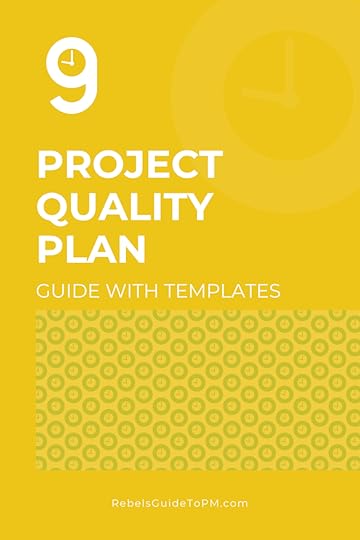 7. An inexperienced project manager
7. An inexperienced project managerIf we take into account the role and all the responsibilities of a project manager, it’s no wonder that many people think that a project manager has the biggest impact on the project’s outcome. They are not only responsible for making sure projects are completed on time and within budget, but they also work with clients and manage other project managers.
The reason why some project managers fail to deliver positive results is not the lack of qualifications or certificate, but the inability to communicate ideas clearly and drive the initiative. A successful project manager should have exceptional social skills and should get the necessary training in project management.
Although managers believe that they will be able to identify and handle all challenges along the way, they simply can’t.
Whatever the cause of the project management failure, dealing with a problem is always a more meaningful solution than ignoring it.
Also, in this way, the team learns important lessons about all the gaps they need to bridge their way to success and gain invaluable knowledge that will help them achieve success in projects to come.
A version of this article first appeared in 2017.
This article first appeared at Rebel's Guide to Project Management
April 10, 2023
Free Issue Log Template For Your Projects

Keeping track of problems on projects is really important if you want to come across as a professional project manager. Nothing makes you look less credible than saying, “Oh really? I don’t know what’s happening about that,” when someone asks you about an issue.
I use an issues log (it’s an Excel spreadsheet) to make sure I record, remember and manage all the issues on my projects. I can filter it by issue status or by issue owner, and I like how flexible it is.
Do you want it too? For free? I thought so.
This free project management issues log template (Excel) is pretty simple but it saves you having to put one together yourself and I can guarantee it works.
You’ll find the template in the project management resource library, along with some other bonus stuff to help you manage your projects more effectively and grow your career.
Access the Resource Library here and I’ll message you back a link where you can download the templates.
Benefits of using an issue logIt’s helpful to have a list of issues by type so you can spend the right amount of time focusing on fixing them out.
You can also keep the relevant details for future reference, so you can look back and review what you did to address the problem. This is very helpful during a retrospective or lessons learned exercise, because it saves time if you hit similar problems again.
The issue register for a similar project can also give you some key risks for future projects — perhaps you’ll see the same problems again? Why not plan for them just in case on your risk register?
How to use the project issue log templateWhen something happens that you weren’t expecting, you’ll record the issue in the project issue tracker template. Note down all the details that you have about the problem, and then you can start working out what to do about it with your team.
I have a complete article on tips for issue reporting, if you want a bit more guidance about the sort of things you should be recording and acting on.
The issue log spreadsheet template includes columns to record the date the issue was raised, the name of the person responsible for doing something about the problem, and space for you to enter the issue description and what action plan you are following to sort it out.
You can add extra columns and change it to make it work for you. You could add additional columns like these:
Issue type or category e.g. technical issuesTime frame for the issue to be addressed inLink to relevant entry in the risk log (if a risk was raised first)Priority levelIssue author – the person entering the details (not hugely important in my view, as I’m the only one who ever logs anything!)(Don’t sell it to anyone though, that’s the only condition).
Who uses the issue template?The centralized issue tracker might be available to everyone, but formal issues are logged and managed by the project manager – that’s you.
You can either set a password to make it so other project team members can’t edit the document, or just set the expectation that it’s yours to update.
What if this isn’t enough?If you need a more comprehensive tracking spreadsheet (and you don’t have that facility in your project management tool) that includes a way to record actions, issues, risks, changes and more, my Project Workbook is perfect for you.
Project Workbook and Budget Tracker $6.00Everything you need to start tracking your project today. This product includes two spreadsheets. Plus a separate Excel spreadsheet for managing your project budget, with worksheets enabling you to track budgeted and actual project costs, purchase orders and invoices.
 Buy Now
Buy Now Meanwhile, don’t forget to grab your free project issue log template Excel version.
To download it, sign up to access the Resource Library here and you’ll receive an email back with a link where you can download the templates.
If you already have access to the Resource Library, you can log in directly here: Resource Library login. And that link is in the footer of this website for when you need to find it again 
 I love using Excel spreadsheets for templates and project tracking.
I love using Excel spreadsheets for templates and project tracking. This article first appeared at Rebel's Guide to Project Management
Strategic Project Portfolio Management [Book Review]
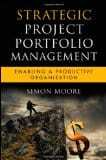
It took me a while to get my hands on Simon Moore’s book, Strategic Project Portfolio Management, but I’m rather glad I did.
For a start, it’s beautiful. I read a lot, and I notice fonts, layout, box copy, but in this book, most of all the lovely tables. Praising a book because it is pretty is probably shallow, but it does matter for the reader experience. And the content isn’t bad, either.
Choosing projects for the best returnsMoore’s book looks at how project management offices should choose and prioritize projects in order to give businesses the best returns. It sounds simple – we all know we should do it, but it’s hard to know where to start for a new PMO.
This book is very practical (another excellent point – I love practical books that tell you how, not just waffle about theory). It covers the whole lifecycle from finding ideas for projects, through the prioritization process and planning for the most productive organization possible.
Estimating for successMaybe best of all, Moore talks about range-based estimates – a topic I’m very interested in. Moore explains that estimates are biased towards the initial values because people don’t adjust their estimates again after making that initial decision. He writes that research:
suggest[s] that in project management, the initial estimate you come to, even if it is determined in a very basic manner, even randomly, has a powerful impact on future estimates due to insufficient adjustment from this starting value. This means that the initial estimate should be delayed if at all possible, or given as a broad range, and the problem of insufficient adjustment should be given real attention by management to ensure that estimates of key factors such as the portfolio budget really do evolve over time to reflect true values. (p. 13)
This makes the case for range-based estimates, but the book is far more wide ranging than this. It’s everything a novice PMO Manager needs to know to support her project managers at work.
One of the other concepts Moore gives time to is the idea of only capturing the data you need. He recommends being pragmatic with monitoring. Why force project managers to record a whole lot of figures that you then do nothing with?
He also points out that the purpose of reporting is to help people make better decisions on the data – otherwise it’s a waste of time.
 Practical advice I’ll refer to again
Practical advice I’ll refer to againThe only point I disagreed with was that late on in the book, when Moore is discussing adaptive project management, he describes Wikipedia as a project.
“Some projects work well without initial planning or organization,” he writes, citing Wikipedia as an example because “there is no planning involved in specifying the articles submitted.”
I wouldn’t call Wikipedia a project – it’s a web-based community initiative, but given that projects are defined (in my world) by having a start, a middle and an end, Wikipedia doesn’t qualify. However, this section is less than a page, so Moore is forgiven.
I did like the ‘10 Things to Do’ and ‘10 Things to Avoid’ chapters – again, practical, solid advice for newbie PMOs and those who know they could be better but don’t know how.
Reading this was a pleasure; I’m sure I’ll refer to it again in the future – and if you work in a PMO, you should too.
This book review first appeared in 2016.
This article first appeared at Rebel's Guide to Project Management
April 9, 2023
Elizabeth Harrin Shortlisted for Business Book Awards 2023
The highly anticipated shortlist for The Business Book Awards in partnership with Pathway Group 2023 has been announced for top business books published in 2022. Authors, publishers, and business figures gathered in London last month for the shortlist reveal party to celebrate the incredible breadth, diversity and quality of business books published last year.
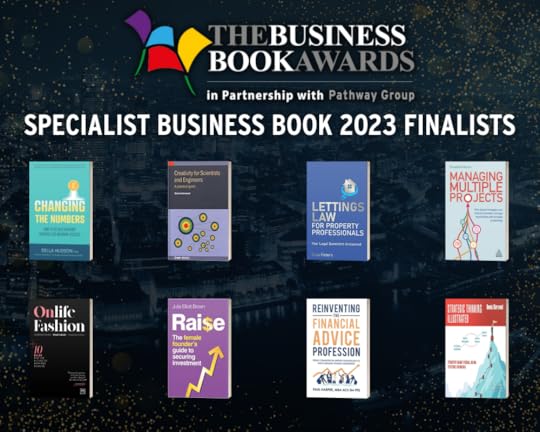
Now in its sixth year, The Business Book Awards celebrate the quality and variety of business books and offer industry-wide recognition to new and established authors writing on a range of subjects for a diverse readership.
Following another year of personal and professional challenges for business people, the 2023 awards cover 14 different categories to reflect the wide range of knowledge and experience required for business success in 2023.
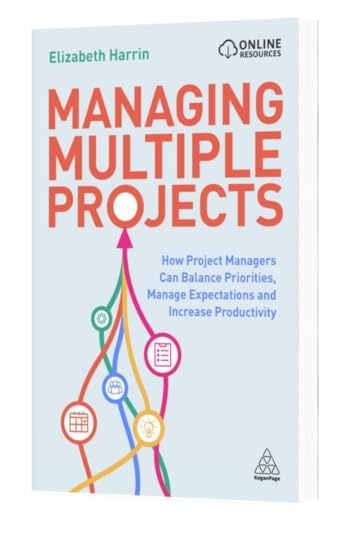
This year 300 books from business leaders and entrepreneurs across the globe were entered into the awards, and Elizabeth Harrin is delighted to have been shortlisted for her book, Managing Multiple Projects: How Project Managers Can Balance Priorities, Manage Expectations and Increase Productivity.
Aimed at people in all kinds of roles who work in projects as part of their job, Managing Multiple Projects will help you develop the skills and knowledge to juggle your workload while avoiding burnout.
Elizabeth said, “This is the book I wish I had read when I started taking on more projects. Combined with the templates that come with the book, readers tell me it has changed the way they work.”
So much of project management training is focused on leading one project successfully, and Elizabeth says she wrote the book to deal with the reality of what modern work is all about: most people involved in projects have to juggle the expectations and deadlines of more than one.
“Project management processes don’t scale up to allow us to streamline and work smarter,” Elizabeth adds. “When you work differently, you can save time and also avoid burning out your team, stakeholders and yourself.”
Managing Multiple Projects is one of eight finalist books within the Specialist Business Book category, with winners of The Business Book Awards 2023 being announced in London on Tuesday 16th May 2023.
To find out more, visit https://www.businessbookawards.co.uk/.
Elizabeth Harrin is available for interview. Please contact her via her project management blog or LinkedIn.
Get Your CopyManaging Multiple Projects: How Project Managers Can Balance Priorities, Manage Expectations and Increase Productivity is a book that offers a comprehensive framework for juggling your workload and still leaving the office on time.
WorderyAmazon UKAbeBooksBooktopiaBookshop.org
This article first appeared at Rebel's Guide to Project Management
April 7, 2023
10 Best Coursera Courses for Project Managers
Are you considering taking a course on Coursera? I’ve done a few, some were better than others!
Professional learning is so important and there are some fantastic courses available on Coursera, which is a really good online learning platform. The interface makes learning very easy as a student… you just have to make sure that you are investing time in the right courses that will help you develop professionally as a project manager.
One of the great things about Coursera is that your monthly Plus subscription includes loads of courses so you don’t have to pay a fee per class. That makes it possible to test out a lot of courses and see which one is going to meet your learning objectives – even if that is simply to earn PDUs!
When I searched, there were over 2,300 ‘project management’ courses on the platform. That’s a lot to work through! Here is my roundup of the best courses available for project professionals.
Top 5 Courses for Project Managers on Coursera Product Name Provider Best For Rating Included With Coursera Plus? / Learn More Top choice Google Project Management Certificate Google Early career professionals 5.0 No See the course Recommended Fundamentals of Project Planning and Management University of Virginia Project managers wanting to improve planning and control 5.0 No See the course 3 Scrum Master Specialization LearnQuest People considering or in a Scrum Master role 4.5 No See the course 4 Project Management Specialization University of Colorado Beginners who don't have the time to commit to the Google course 4.0 Yes See the course 5 Career Success Specialization University of California, Irvine Early career professionals wanting rounded business skills 3.9 Yes See the course Top choice Google Project Management Certificate Google Early career professionals 5.0 No See the course Recommended Fundamentals of Project Planning and Management University of Virginia Project managers wanting to improve planning and control 5.0 No See the course 3 Scrum Master Specialization LearnQuest People considering or in a Scrum Master role 4.5 No See the course 4 Project Management Specialization University of Colorado Beginners who don't have the time to commit to the Google course 4.0 Yes See the course 5 Career Success Specialization University of California, Irvine Early career professionals wanting rounded business skills 3.9 Yes See the course The Full Top 10The table above summarizes my recommendations for the top 5 courses for project managers. Below, you’ll find lots more detail about what courses I have taken and what might be a good fit for you.

How I made these recommendations
In order to review and recommend the training courses, I did some of them completely (Google and LearnQuest), audited others (taking the training but not the assessments so I could do them for free) and did a desk review of others, looking at their content, relevance to project managers, student reviews and more.
1. The Google Project Management CertificateThis is the reason I went on to Coursera in the first place. There is so much hype around this course and I wanted to see if it was worth it.
Spoiler: I think it is, for new entrants to the profession, people who want to make a sideways move into project management and students looking for an extra certificate to go along side their university studies. If you already have 3+ years of experience as a project manager, you probably won’t learn much new.
Best for: People who want to become project managers. People who love earning Credly badges to show off on their profile!
Recommended Google Project Management Certificate 5.0
Google Project Management Certificate 5.0 A solid, professional, well-recognized project management course from a great training provider. Perfect for beginners and people interested in learning more about project management as a career.
Learn more Read my review We earn a commission if you click this link and make a purchase, at no additional cost to you #ad 2. UVA Darden’s Fundamentals of Project ManagementThis was a short course that I worked through by auditing the materials. I did not pay to take the final assessment exam, but I did watch the videos.
I thought the content was in-depth (at least as far as it could be in a course designed to be done in a day) and relevant for people working in a predictive environment.
This one is quick, from a well-respected provider and a great way to upskill especially around creating project schedules.
Do in a day Fundamentals of Project Planning and Management 5.0
Fundamentals of Project Planning and Management 5.0 A great short course from UVA Darden covering the basics at a good level. Best for project managers with some experience who want to improve their planning and project control.
See the course Read my review We earn a commission if you click this link and make a purchase, at no additional cost to you #ad 3. University of California, Irvine’s Career Success SpecializationThe first course in this 10-course Career Success Specialization is on project management. The other courses cover equally important topics for people wanting to excel in a project leadership role:
Personal productivityFinance for non-finance professionalsCommunicationBusiness writingNegotiationManagement fundamentalsProblem-solving and decision-makingEntrepreneurshipAnd it ends with a career success project class which has peer-reviewed assignment. In turn, you have to review the assignments of 3 other students.
These courses are best for people working in a business environment already. The career project Capstone looks like it requires you to talk about your own organization so if you don’t have one that could be a problem.
Plus, one of the trainers is Margaret Meloni, long-time friend of this site and expert in work breakdown structures amongst other things.
No time for 10 courses?
There is a shorter UCI course called Project Management and Other Tools for Career Development. This seems to be a shorter version of the full Career Success course.
4. University of Colorado’s Project Management SpecializationThis is a 3-course Project Management Specialization that is part of the MEng degree so you get academic credit for it.
The courses cover foundations and initiation, planning and execution and the final one is on agile.
This is aimed at beginners, so give it a miss if you already have some experience.
5. LearnQuest’s Scrum Master SpecializationI thought from the title, the LearnQuest Scrum Master Specialization course would end up with me being a Scrum Master, but having completed this course, you can’t walk away from it saying that.
Once you are in the specialization, the trainer, Jim Sullivan, explains how it fits with the other two courses required to prepare you for the exam. Then you have to take the exam, which is not offered through Coursera.
However, I did learn a lot about working as a Scrum Master and the skills involved. I do not have a background of Agile, so it was helpful to get a real deep dive into the different tools and techniques as well as Scrum ceremonies.
The training is aimed at beginners and covers the foundational knowledge required to operate in a Scrum environment. If you want to find out if being a Scrum Master is for you, this specialization will give you all the basics.
You have to pay for a monthly subscription to take it, or buy each course separately.
 I completed this specialization and earned the certificate6. IBM’s People and Soft Skills Specialization
I completed this specialization and earned the certificate6. IBM’s People and Soft Skills SpecializationThe reason I’ve ranked this one is because it’s another one that gives you a Credly badge so you have something meaningful to show for your achievement.
The People and Soft Skills for Professional and Personal Success Specialization from IBM has good course content. I found the delivery style pretty boring in comparison to the Googlers and the UVA Darden tutor, all of who mastered their content and delivery, and had nice-looking slides.
The training materials sound like they are being read by AI software. You can’t do the quizzes on the mobile app either, you have to do them on a proper computer.
But if you are new to the workplace, you’ll pick up some useful tips on how to work effectively with other people and develop what PMI calls Power Skills, and what IBM calls Success Skills. And no one can argue that they aren’t needed.
 At the time of writing I have not yet finished this course, but I’ve done the vast majority of it. 7. Agile with Atlassian Jira
At the time of writing I have not yet finished this course, but I’ve done the vast majority of it. 7. Agile with Atlassian JiraI have lost count of the number of project managers I know using Jira for project management. This course has great reviews, with over 239,000 students already.
Agile with Atlassian Jira has 4 modules that cover agile basics and configuring Jira, as well as hands-on experience with Jira Software Cloud. The course includes instructions of how to access a free Jira Software Cloud site to complete the lab exercises, so you’ll need a computer to do that, you can’t use the Coursera app.
While this course is a complete, practical learning experience, it’s also the basics for the Atlassian University credential, Jira Cloud Essentials with Agile Mindset Pro Skills Badge. Use this course as your learning and then apply to take the exam on the Atlassian website.
8. Excel Skills for Business by Macquarie UniversityI always want to learn more about Excel, probably because I quickly forget how to do the best formulas. I’m constantly looking up how to save time with Excel shortcuts.
For all that I support organizations migrating to enterprise project management tools, I know that many businesses, my own included, rely on Excel for a lot of data processing, stakeholder list-making and even reporting.
It’s important to know how to get the best out of Excel as I can guarantee you’ll be expected to use it as a project manager.
The Excel Skills for Business Specialization is 4 courses that will take you from essential skills to advanced level knowledge, where you’re building professional dashboards in Excel.
9. Improve Your English Communication SkillsOver half a million people have already enrolled in the Improve Your English Communication Skills Specialization, so it’s a popular choice for people wanting to write and speak more professionally in English.
The four courses cover:
Writing professional emailsSpeaking professionally in person, online and on the phoneBuilding a professional ‘ePortfolio’ which is basically making sure you have a professional-looking social media presence and LinkedIn profileCapstone project for next-level skills which covers cultural influences on communication and practical exercises to build your confidence and help you gain experience and feedback through peer assessments.If English is not your first language, or if you are not confident in your business English levels, then this could be a good option for you.
I was offered a free trial of this course, and the price you’ll pay after the 7-day trial is up will depend on where you are in the world. It was £40 per month for me. I would recommend trying it using the free trial to see if it is a good fit for your level of English and confidence.
10. Wharton’s Business Foundations SpecializationI wasn’t sure what to expect with the Wharton Business Foundations training, but it is a good overview of a lot of different business topics. It’s a 6-course series, so be prepared to commit for the long term. If you only do a couple of hours a week you can get through it in around 7 months, but I would suggest dedicating a bit more time per week and getting through it faster if you can.
Faster = cheaper on a monthly subscription to Coursera Plus or the Specialization itself.
It’s a course that is not specific to project management but includes a lot of general business knowledge that provides context and useful skills for engaging with your colleagues in other departments.
It covers marketing, financial accounting, managing people, corporate finance, operations management, and a Capstone project as the final course. The expectation is that you submit your project for peer review before you devote too much time to researching it, so this is a robust way to shape out your knowledge and put what you have learned into practice.
Best for: People who want to know how businesses work and how the commercials and financials work to support business development.
You made it all the way to the bottom? Which course will you sign up for next? Product Name Provider Best For Rating Included With Coursera Plus? / Learn More Top choice Google Project Management Certificate Google Early career professionals 5.0 No See the course Recommended Fundamentals of Project Planning and Management University of Virginia Project managers wanting to improve planning and control 5.0 No See the course 3 Scrum Master Specialization LearnQuest People considering or in a Scrum Master role 4.5 No See the course 4 Project Management Specialization University of Colorado Beginners who don't have the time to commit to the Google course 4.0 Yes See the course 5 Career Success Specialization University of California, Irvine Early career professionals wanting rounded business skills 3.9 Yes See the course Top choice Google Project Management Certificate Google Early career professionals 5.0 No See the course Recommended Fundamentals of Project Planning and Management University of Virginia Project managers wanting to improve planning and control 5.0 No See the course 3 Scrum Master Specialization LearnQuest People considering or in a Scrum Master role 4.5 No See the course 4 Project Management Specialization University of Colorado Beginners who don't have the time to commit to the Google course 4.0 Yes See the course 5 Career Success Specialization University of California, Irvine Early career professionals wanting rounded business skills 3.9 Yes See the courseThis article first appeared at Rebel's Guide to Project Management



